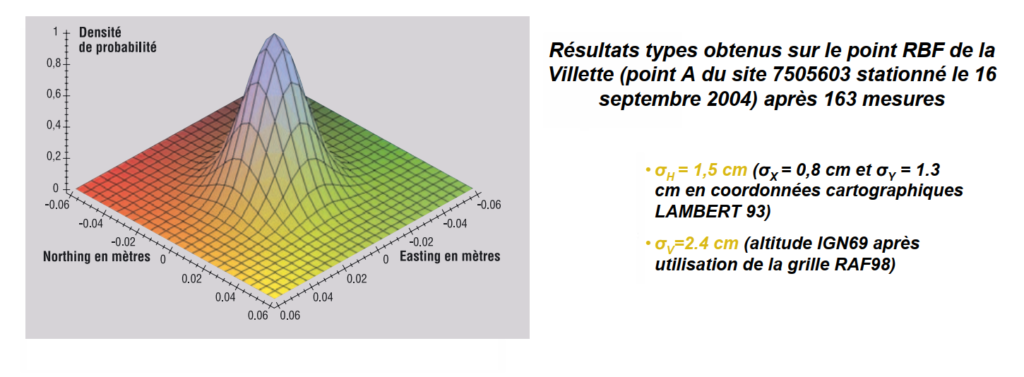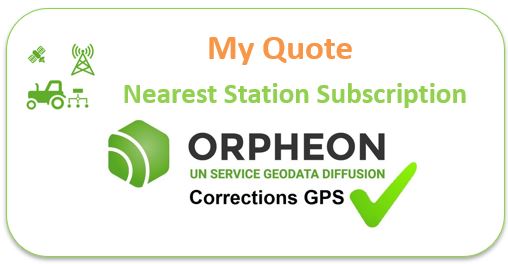
Connect permanent GNSS stations in a network to a computing center
For greater precision, the observation signals from the permanent GNSS antennas of the Orpheon network are grouped together on a server which will allow better signal processing and better determination and modeling of error sources by using:
- Predicted ultra-fast orbits with an inaccuracy of 5 cm corresponding to 3 ns instead of broadcast orbits which have a greater inaccuracy of 100 cm or 5 ns.
- Additional weather models, particularly tropospheric
- Geophysical models (tide and induced oceanic overload, solid tide, polar tide, atmospheric overload, etc.)
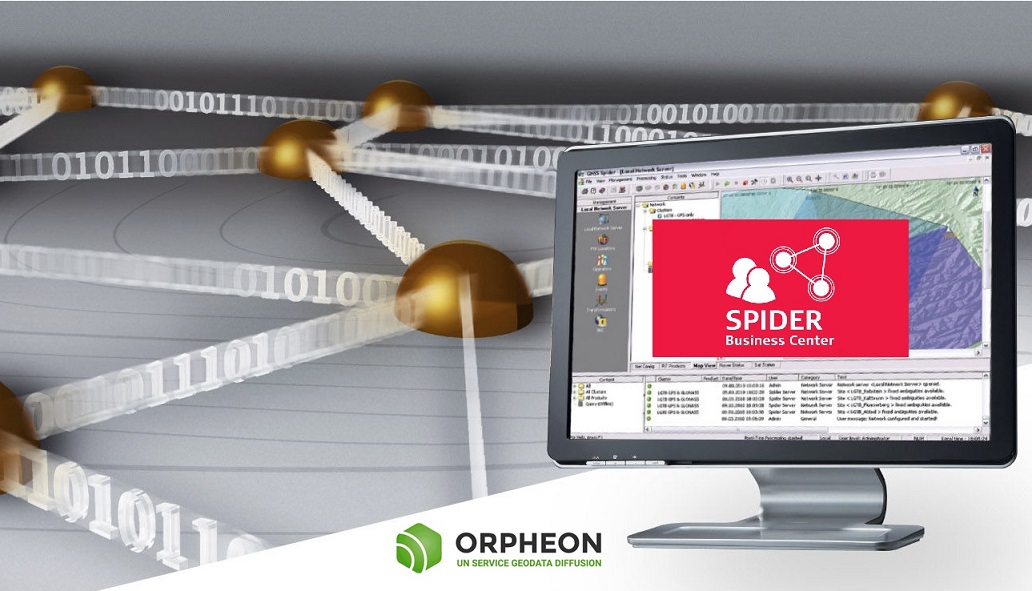
Signal processing and coherence
In network mode, the correction data sent to each user come from a cell of several reference stations based on common satellite observations. It is necessary that the equipment making up the infrastructure of the network but also the bases of the permanent stations of the network are all compatible with all of these different constellations of satellites in order to be able to deliver a complete and coherent correction corresponding to the different users in the field.Capacity increase
The increase in the number of constellations with the arrival of Galileo and Beidou as well as the growing number of network users require the power and capacities of the NRTIP servers used by the network to be constantly upgraded. By being part of the Hexagon group, the Orphéon network has adapted and comfortable resources, but also a team of experts dedicated to the supervision and maintenance of the infrastructures to ensure a very high level of availability of the Orphéon services.
Guarantee the availability of the real-time service
To be able to offer the best rate of availability of data and correction services, we have optimized our infrastructures and implemented leading technical solutions. As corrections are disseminated in real time, it is essential to have better infrastructures that can guarantee all data flows:- The data streams from our stations to feed the servers
- The incoming and outgoing data flows the positions and corrections of each user
-
-
- Receive observations from permanent stations on the computer center
- Make them temporally consistent
- Calculate “corrections”
- Send “corrections” to user
-
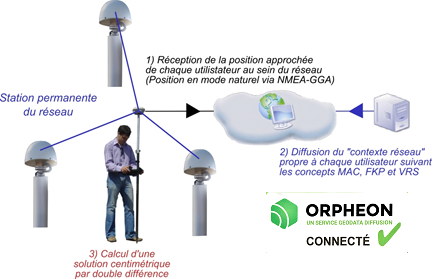
We have therefore chosen a very efficient infrastructure
The implementation of this telecommunications network guarantees us the lowest possible latencies (data transmission time) between the permanent stations of the entire network and the computing center.
Goal: Have the lowest latencies
This uncompromising choice, in order to put the user’s mobile in the best possible situation by allowing it to receive as many corrections as possible in the most fluid and continuous way. The load rates of a private network are guaranteed by the telecom operators offering this type of service. Such a network is also much more available than the Internet, the redundancy of the links being provided by the operators in charge of its operation.In the chain of transmission of corrections:
Le lien GPRS entre le GPS et nos serveurs NTRIP permet to route 95% of the corrections with a latency of between 0 and 1.5 seconds, hence the crucial importance of this MPLS-type network in terms of latency. A rover configured in interpolated mode (“accuracy” mode at Leica, “forecast” at Topcon and “Low Latency” at Trimble) can typically last 3 seconds without receiving corrections.
Why is an ordinary internet connection not enough?
The Internet is a network that pools resources for all users, on the principle of “best effort”, even if the performance deteriorates very sharply. The use of the Internet is therefore not relevant here, insofar as we wish to guarantee and control transmission times (latencies). The Orphéon network therefore does not undergo these “slowdowns” in order to be able to perform its correction calculations.
Full GNSS infrastructure
With the idea of reducing transmission delays (latencies) as much as possible and increasing the availability of our services, powerful and reinforced machines used to calculate the NRTK correction, now Full GNSS, are hosted in a Datacenter located at the heart of the our telecommunications operator, that is to say as close as possible to its own machines. The infrastructure and correction calculation software allow us to distribute “Full GNSS” corrections (GPS + GLONASS + Galileo + BeiDou)
- Infrastructure designed for service performance
- No loss of time between reference stations and servers
- Powerful computing servers
- Optimized data paths
- Lowest latency times
- Services always backed up with the same performance
On this Datacenter, each element of the network (GNSS sensor, station modem, inverters, etc.) is “seen” as if it were local and is able to independently send all the information necessary for its proactive maintenance.
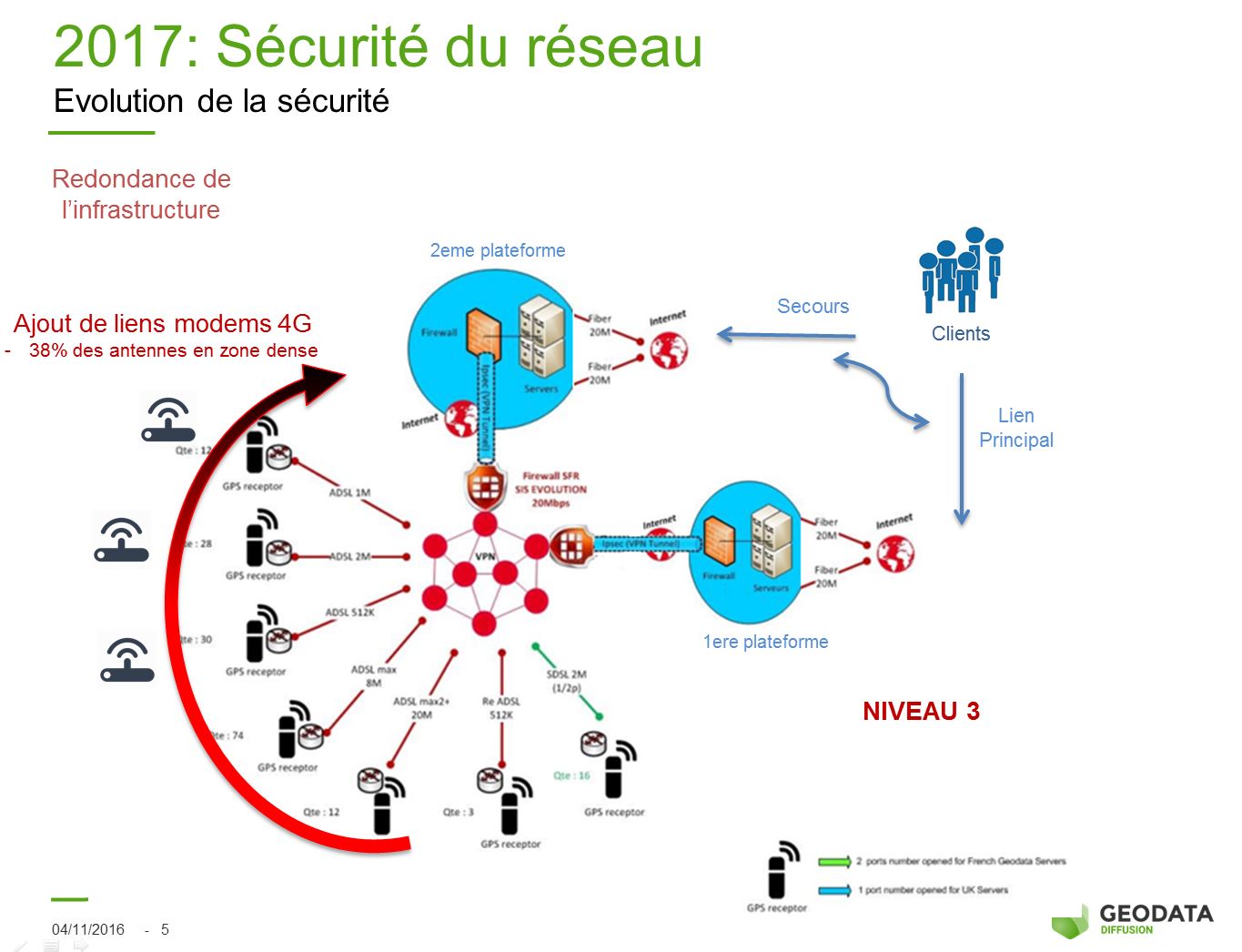
Evolution of network security
Level 1 security
A secure installation from the start
In 2006 during the creation of the infrastructure, the first platform received all the necessary attention so that all the equipment of the platforms but also the internet links are duplicated
- Owner of all equipment
- Internet links are duplicated
- The servers are doubled
- Connection and patching equipment
- Supplies are doubled and backed up
- Reference stations connected via VPN on a private network
Level 2 security
In 2016, the installation of the second platform and the implementation of an address server (DNS) made it possible to strengthen the availability of corrections but also to share technical support within an expert and dedicated.
- Installation of a second platform
- Adaptable virtual machines on demand
- DNS address server for a serene failover
- Shared technical support
Level 3 security
In 2017, the installation of 3G/4G modems on our reference antennas makes it possible to double VPN internet connections and reduce the connection problems that an ADSL or SDSL line may encounter.
- doubling of reference antenna connections: ADSL + 4G connection
Two redundant calculation lines
At the heart of each platform, two perfectly redundant and separate computing lines are installed in order to guarantee the continuity of service according to the equipment used by our customers.
- The Spider Leica calculation line has its 2 separate servers
The vital elements of each machine are also doubled (processors, hard drives, RAM units, power supplies, network cards). These computing lines are powered by two independent electrical feeds, themselves corrugated and backed up by generators and battery rooms. They are also cooled by two independent air conditioning lines.Two data centers
The Hexagon group has selected two separate data centers in two different countries to host the servers for all of its IT infrastructures in the HxGN SMARTNET European network. A team of specialized engineers is dedicated to the design and supervision of all of these servers, ensuring the continuity of services 24/365.A second platform
A second platform equipped with virtual machines (VM) has been set up in a different location from the data center of the first platform in order to guarantee permanent access to geo-positioning correction data in all circumstances. This solution also makes it possible to benefit from resources and scalable equipment available according to our needs and the growth experienced by the use of GNSS geo-positioning correction, particularly in new markets. This second platform is an identical copy of the first platform and overcomes all problems relating to internet connections.
- High availability of Orpheon services
- A main platform with reinforced security
- A backup platform in another data center
DNS address server
Since our two infrastructures are independent, a different IP address is assigned to them. Thus, any switch from one platform to the other would involve reconfiguring your GNSS hardware with another IP address. To avoid such a procedure, we have set up a DNS service (Domain Name System) which will perform the change of IP address automatically. Thus, in the event of maintenance or a problem requiring a change of infrastructure, your GNSS equipment will automatically connect to our services. The establishment of the address server (DNS) thus makes it possible to switch when necessary from one platform to another in complete transparency for customers.
- A DNS address server
- No hardware reconfiguration
- An Orpheon service available immediately on another platform
- A fast, transparent and serene changeover
Increased monitoring
The implementation of identical and distant platforms allows us to have homogeneous and standardized installations within the Hexagon group. This homogeneity thus makes it possible to extend the size of our support teams and allows them to intervene at any time, 24 hours a day, regardless of the place or the country where our support engineers are based.
-
-
- High surveillance 24 hours a day
- Homogeneity of installations
- Shared technical support
-


